Occasions for your employee survey
When designing employee surveys, there are different types of questionnaires. A distinction must be made between time-based and occasion-based questionnaires.
Scheduled questionnaires
This type of employee survey can be conducted annually, quarterly or even monthly. Time-based surveys are useful for generating benchmarks and identifying trends at an early stage.
In the best case, measures can be derived from these surveys, which can be worked through in a defined period of time and checked by a subsequent survey.
Mood or pulse survey
An example of a regular employee survey is annual satisfaction surveys such as mood surveys or pulse surveys.
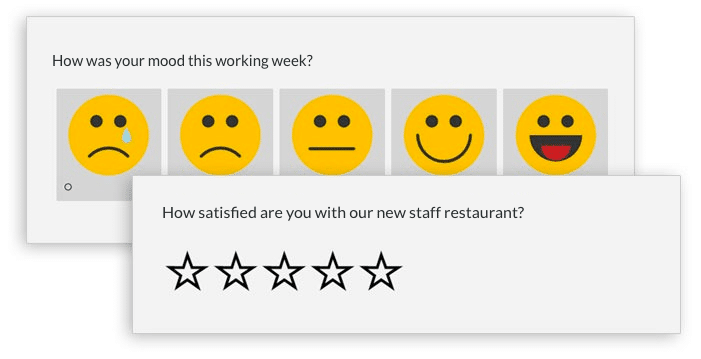
This survey usually polls the entire workforce to gain short-term insights into changes in the work atmosphere. There are countless ways to use it, here are two popular ways from the field:
- If there are current or recent major changes in your organization, you can use this way to learn how well employees are doing and if they still feel comfortable.
- Another possible use is to ask about the health of your employees or their stress levels.
In this way, you can also increase your attractiveness as an employer through regular employee satisfaction surveys.
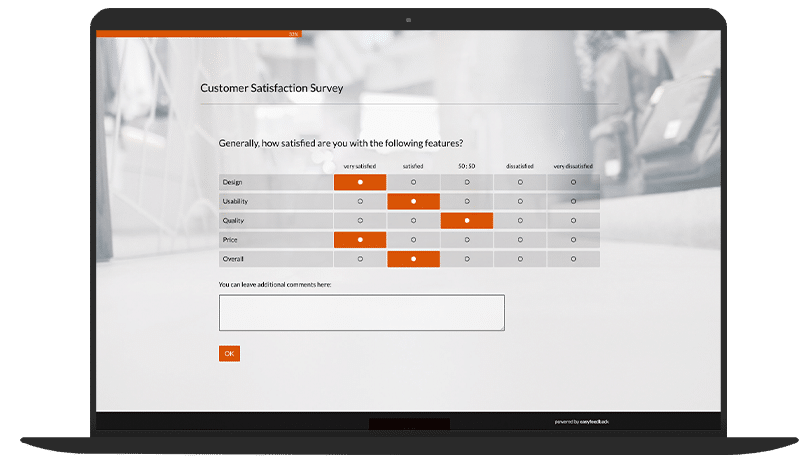
Occasion-related questionnaires
In addition to the scheduled questionnaires, there are also occasion-based employee surveys. These focus on specific stages in the employee lifecycle.
1. Recruiting
During recruiting, you can collect information at different points in time. This gives you different insights into the respective process steps.
For example, you can ask future employees for important information after they have uploaded their application documents using an online questionnaire. Or even after the interview and after the application process has been completed.
The findings can help make the application process more efficient and easier for your applicants.
2. Onboarding
Every company has a different take on a good onboarding program for their new colleagues. For some companies it’s a whole week, for others it’s just one day packed with events.
But many companies lose sight of the most important thing: the new employee.

For this reason, it is important to conduct a survey of new employees during the onboarding process in order to constantly improve your program.

The timing of such an employee survey is especially important. You should not survey your new colleagues directly in the first week, but also not after half a year. A good time is usually after two or three months.
3. Further training
Nowadays, feedback after internal training is almost a matter of course. However, feedback from employees after external training is hardly common.
These results are just as important as those from internal training, but remember that external training is usually more costly.
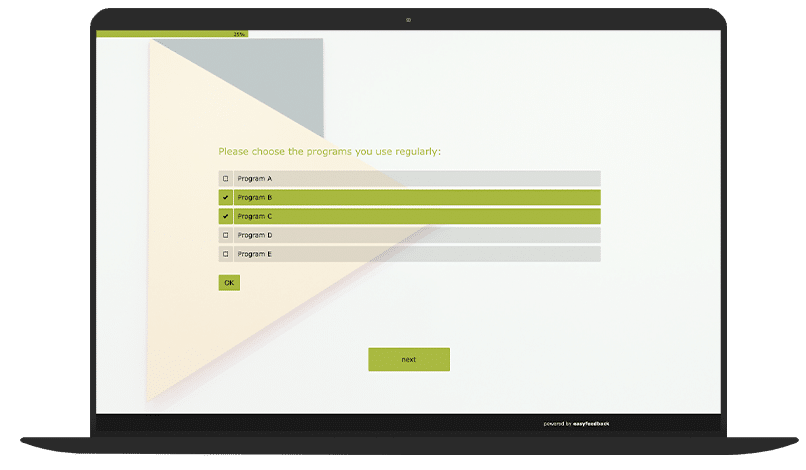
If you collect this information, you will get an insight into which measures are relevant for your colleagues. Or which further training should no longer take place, or at least not in this form.
This allows you to create a training catalog that is tailored to your employees.
4. Strategy development
An employee survey can also be used for strategy development. The first step would be a recording of the current state. Afterwards you can get further insights and ideas with personal interviews and create your strategy based on this.
The advantage of this type of strategy development is that the workforce is involved. As a result, colleagues will accept and move forward with this strategy and the resulting measures.
5. 360-degree feedback
360-degree feedback is a fully comprehensive feedback for an employee or a manager. The feedback givers, stakeholders, managers, employees and also customers, give feedback to the feedback receiver from multiple perspectives.
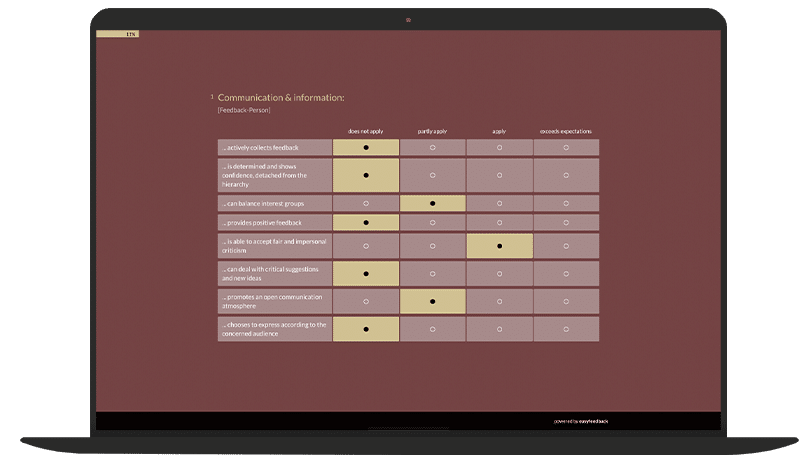
The goal of this 360-degree survey is to provide the employee with an overall picture and to show him on which levels he can improve.
It is also an important tool for managers to gain a precise insight into the employee’s working methods and social skills.
For this reason, this feedback should be conducted annually before the appraisal interview so that the results can be included in the evaluation and a development plan tailored to the employee can be created.
6. Executive development
Feedback from employees is essential for the development of a good leader. This survey should be conducted at regular intervals in order to be able to recognize a development and improvement of the leadership style.
It is important that the employees give an honest feedback and do not have to be afraid to be addressed by their boss afterwards. Therefore, the choice must be made for an anonymous questionnaire.
It is also important to leave room for comments in this type of employee survey. Especially these insights can show a manager in which areas there is a need to catch up.
7. Exit
The termination of an employment relationship is one of the most important times for an employee survey during the employee lifecycle.
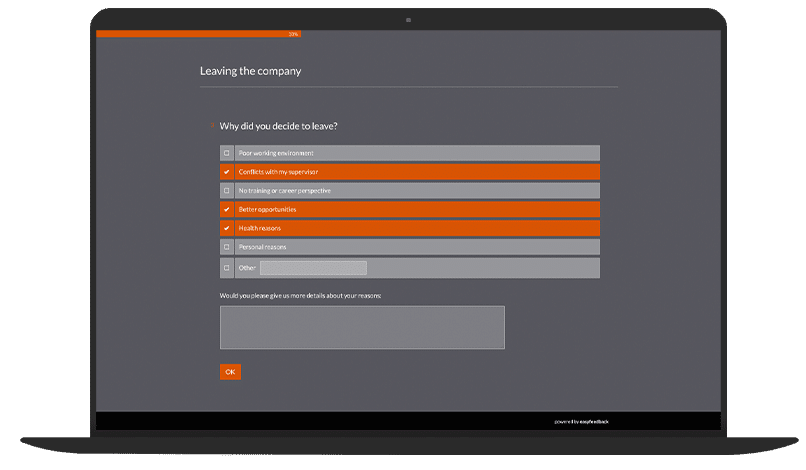
The aim of this feedback is to find out the motives for the termination. The motives do not necessarily have to be related to the current position.
However, if it is factors from within the company that caused the employee to decide to leave, you should try to eliminate these issues as much as possible afterwards to prevent further departures.
As you can see, there are many ways to use questionnaires for employee surveys. The design of the questionnaire is therefore all the more important in order to achieve appropriate and meaningful results.
Designing the ideal questionnaire
When designing questionnaires, you should pay special attention to the following points in order to achieve not only a high participation rate, but also authentic results.
Please always remember to involve the works council in your considerations regarding an employee survey at an early stage. They may be able to provide you with important information regarding individual employees or groups of employees and serve as a sparring partner when designing the questionnaire.
>> Video: 8 tips for building your questionnaire <<
Quantitative vs. qualitative
In general, questionnaires can be divided into quantitative and qualitative surveys.
- In the quantitative employee survey, mostly online surveys or written questionnaires are used to reach the entire workforce. With this methodology, you get your feedback in facts and figures.
- Qualitative employee surveys usually involve interviewing a small group of employees through personal conversations or discussions. Through this methodology, deeper insights into defined topics or specific situations can be gained.
Transferred to our occasions for employee surveys described above, this means: Mood surveys but also conversations in the context of recruiting are typical examples of a quantitative survey, since a large group of people is interviewed here.
In contrast, the exit interview would be an example of a qualitative survey, since we can only obtain more detailed information about the motives of employees who have quit.
The third possibility is obvious, the combination of both methodologies. If, for example, you have not yet obtained the information you need from the quantitative survey, you can follow up with a qualitative survey.
It can also happen that a group of employees has a completely different view of a situation than the rest of your staff. In this case, you can also follow up with a qualitative employee survey to get more information about the situation.
Confidentiality
>> Video: Increase acceptance of employee surveys <<
Once you have decided between the methodologies, the next relevant issue is confidentiality.
To get honest feedback, you need to give colleagues the opportunity to answer the questions anonymously. Many people are afraid to express their true opinion for fear of the possible consequences.
For this reason, you should assure your colleagues in advance of the employee survey that the survey will be treated confidentially and that tracking is not possible.
Tip:
The easyfeedback software includes an anonymity function and other mechanisms to ensure the anonymity of your employees. This gives you the option to conduct the survey online.
However, not every employee survey has to be conducted anonymously. It may not be necessary to make the survey anonymous if it is conducted as part of the onboarding process, in relation to further training measures or when an employee exits the company.
When conducting an anonymous employee survey, pay particular attention to the questions you ask and make sure that employees cannot be uncovered by indirect questions at any point in the questionnaire.
This primarily refers to questions about the department, length of service, gender and hierarchy level. If you include these or similar questions, there is a very high chance that your employees will feel deceived and will not answer the questionnaire honestly and authentically.
However, in order to be able to roughly allocate the results in the evaluation, you could, for example, ask about the company division or the place of work (especially in international companies).
As long as you do not ask too many of these questions, it is usually not possible to identify a single employee.
Also, avoid any kind of restriction so that employees can take the survey at a location of their choice. This gives employees the opportunity to take the survey in a private place where they can express their opinions without the influence of others.
Online software that allows you to make your employee survey available on the web is the ideal way to do this.
Not too long and not too short
>> Video: How many questions are useful in a survey? <<
But how much time are your employees willing to invest in answering the questionnaire?
Unfortunately, there is no general answer to this question. The time it takes to complete the questionnaire depends on various factors, such as the methodology, the occasion or the relevance for the employee.
You should therefore always ask yourself whether answering the questions is primarily relevant for the employee and implies that work is being done on a topic that is relevant for him.
Or is it only relevant for your company to get this information and insight. The answer to this question makes the difference between whether employees are willing to invest more time or whether they will only spend a little time answering the questionnaire.

As a rough guideline, employees are willing to invest about 20 to 30 minutes as long as the survey is relevant to them.
However, for a regular employee survey, such as a monthly sentiment survey, the participation rate will drop precipitously if employees take more than 10 minutes to respond.
For this reason, you should clearly communicate the completion time or number of questions in advance of the employee survey. With this clarity, employees will plan enough time and the dropout rate will likely be low.
Questions upon questions: Choose the right question types
The next step in designing an ideal questionnaire is choosing the right wording and question types.
Basically, a distinction is made between open and closed questions. The decision for the respective question type depends on the output and the results you want to achieve with the employee survey.
Open vs. closed questions
Open-ended questions are direct questions in which no answer option is given. The respondents can usually enter their answer in a text field.
This form of question is therefore particularly suitable if you want to record wishes and ideas or also the employees’ perception regarding a specific situation.
Examples of open questions are:
- What should we change about our hiring process?
- What benefits do you think we should offer?
Closed questions are indirect questions in which answer options are predefined and are thus usually quicker and easier for respondents to answer.
The evaluation of these questions is also significantly faster than that of open questions. This form of question allows you to quickly identify trends within the workforce.
Answer options for your employee survey
There are different ways of designing answer options for closed questions. You have the possibility to use scales, different answer options or even tables.
Creativity knows no bounds here, so I’d like to show you a few samples below that you can map online with any good software.
Here is some food for thought:
1. The simplest form of closed question is the so-called “dichotomous question”, where there are exactly two possibilities. As a rule, this is the classic yes/no question. For example:

2. Another option is to specify different answer choices. Here is an example:

3. The evaluation of individual measures or capabilities is mostly done in tabular form of a Likert scale. It is controversial whether respondents are given an even or odd number of choices.
With an odd number of choices, employees can choose to make a neutral statement. In the case of an even number of choices, the employee must decide in favor or against.
A gradation of 5 points is recommended. This gives employees the opportunity to make a neutral statement.
An example of a Likert scale:
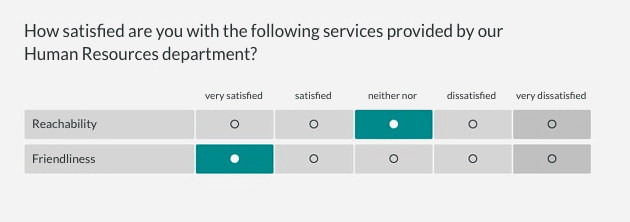
Another form of presentation to query employee satisfaction on a delimited topic is the evaluation by means of a slider. For instance:

In addition, there is the “semantic differential question” or also called “polarity profile”. You can show the participant pairs of characteristics on a certain topic, which he judges from his perception. With this type of question, the employee is driven to a spontaneous answer.

In the case of a compulsory question, it is also advisable to list the answer option “No answer“.
You should include this answer option especially when it comes to questions about processes, for example, with which a large part of the workforce have contact.
This option prevents the results from being distorted and you only receive feedback from employees who have an opinion on the statement or question.
Wording
The way you phrase questions largely determines the feedback you receive. For this reason, it is important to understand the importance of question wording. Questions can be phrased positively, neutrally or negatively.
Examples of these formulations are as follows:
- neutral: What do you think of our company logo?
- negative: Don’t you think our company logo is awful?
- positive: Don’t you think our company logo is beautiful?
Be careful to keep the questions as neutral as possible so as not to steer respondents in one direction. If you use positive or negative phrases, the participants will be influenced and you will have distorted results in your evaluation.
Since the participants have no opportunity to clarify ambiguities during the employee survey, it is imperative that the questions are unambiguous and clearly worded. A good way to check this is to present the questionnaire to an uninvolved colleague in the company and talk to them about how they understood your wording.
Structure of the ideal questionnaire: The order makes the difference
Do you have good software at hand to map your questionnaire? Your fingers are tingling and you’re just waiting to start typing and get your employee survey online?
Before you do that, take some time to think about the right order of the different elements of your employee survey:
- At the beginning of the questionnaire, you should write an introduction for the respondents. Explain the reasons for this employee survey and give the colleagues an idea of what their benefit can be from participating.
- If you want to cluster respondents into specific groups, the next part of your survey should be about formal information. Here you can ask what seniority level the colleagues have or in which department they work.
As already described above, you should question each of these details carefully so that an anonymous survey really remains anonymous. - In the next part, everything finally revolves around your questions. Pay attention to the order here as well:
a. Make sure you start with the most general questions possible and get more specific and concrete as the employee survey progresses.
For example, you could start with a general question, such as “In what area can we improve working conditions for you?” This question can be given answer options.
b. To gain more specific insights, a follow-up question should be asked. A follow-up question can be an open question in which the employee is free to express his or her opinion, or it can be filled with in-depth answer options for the respective topic area.
Furthermore, the credo of the questions should be from simple to complex. In this way, you slowly introduce the respondents to more complex topics and don’t open the door to them. - You can also give the surveyed employees the opportunity to express their personal opinion in a free-text field, also known as a comment field.
The comment field does not necessarily have to refer to the questionnaire, but can be a general call for opinions. It is recommended to place this question as a closing question in your questionnaire.
By such a call, you give the employees the opportunity to get rid of everything that might bother them. Such a field does not fit into every employee survey and should therefore only be used if it offers added value. - Last but not least, you have the opportunity to thank your colleagues for their participation on the final page of the questionnaire and explain the next steps to them.
Expert tip:
Depending on which survey you are conducting, it makes sense to sort the questions thematically, so that you provide the employees with a common thread during the survey.
Also try to include different types of questions. This generally increases the respondent's concentration and improves the quality of the answers, as mindless answer patterns are avoided.
A simple way to take these tips into account is to first write down all the questions and then sort them according to complexity and topic. Afterwards you can use different types of questions to bring more variety into the survey.
Conclusion: More appreciation and better input with a well-designed questionnaire
With a well-constructed questionnaire, you gain valuable insights that serve as a decision-making basis for measures to optimize employee satisfaction.
Employee surveys don’t just have to be initiated by HR, they can also come from employees. Always offer your employees an open ear and listen to them, so you get important input to better position your company as an employer.
Another inspiration can be speeches at company meetings or similar events. Here your employees have a platform to share their thoughts. When they do, you can use this as an opportunity to get a general survey rolling.
By doing this, you show your employees that their opinions are important to you and that you are willing to strive for change. The responses in such an employee survey will be more honest because the whole survey is done with the employees in mind and they see relevance in it.
Employee surveys are indispensable for these reasons to express your appreciation. Not only do you get the answers to urgent questions, but you also help to strengthen the satisfaction in your company.
Here I would also like to mention that employee surveys should not only be conducted out of the interest of the HR department. Employees usually only give honest answers, or participate only if they get a personal benefit from it.
This is how you can improve employee satisfaction in your company.
More about employee surveys
- How to increase acceptance of employee surveys
- How to involve the works council in employee surveys?
- Conducting anonymous employee surveys: Best practices and tips
- How much does an employee survey cost?
- 8 tips for conducting your employee survey
- 8 tips for evaluating & analyzing your employee survey




